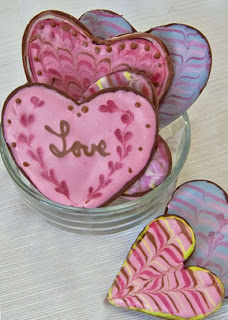 Recently I posted about my switch from decorating with regular commercial liquid food dyes to all-natural botanical alternatives. I explained here why I think this was a smart health decision and provided a lot of other details.
Recently I posted about my switch from decorating with regular commercial liquid food dyes to all-natural botanical alternatives. I explained here why I think this was a smart health decision and provided a lot of other details.
I promised that I’d follow up with an icing recipe to use with the “naturally beautiful” dyes. In the meantime, I also got an e-mail asking how to create the interesting geometric designs shown on some of these cookies (like most of the ones at left).
So, I here I show you step-by-step how one very eye-catching effect is created.
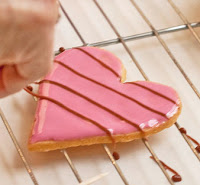
The technique is called marbling, and it’s a classic decorating method European pastry chefs have long used to quickly dress up fancy tortes and other pastries. Don’t worry, it’s easier than it looks!
Yes, the marbling can involve using a variety of different colors and very tidy piping (my pink striped cookie in the top left pic features red, brown, lime green and white!). But it doesn’t have to be at all elaborate or even perfectly piped to look impressive.
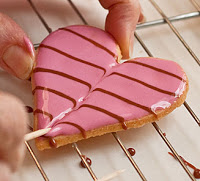
The main thing to remember is that the designs need to be completed while icings are still wet. So, it’s best to have everything ready and within reach in advance. The toothpicks should be handy, the icings made, and the accenting icing(s) placed in a piping bag or cone.
As the four pics at right reveal, the basic technique is fairly simple: After covering a cookie with a fairly fluid icing, immediately pipe spaced lines in a contrasting color (or colors) over the first layer. You can use a piping bag fitted with a fine writing tip; or a paper decorating cone; or a sturdy plastic baggie with one tiny corner snipped off. Don’t worry if your piped lines aren’t perfect; the finished cookie will still look very impressive!
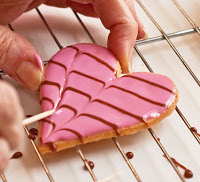
As soon as the lines are completed, use a toothpick to draw across them to marble the colors and create the geometric design. It may be easiest to start in the middle, then draw down through at regular intervals on each side, as shown at right. It’s also possible to draw through the lines working from the bottom to the top, or by drawing downward with one line, then upward with the next for another interesting look.
In smaller heart cookies three vertical lines is enough to dress up the entire surface. However, five marbling lines looks great on larger cookies. The only real key to success is to finish working while the two icings are still wet enough to blend and flow together and dry with a smooth surface. (If you are curious about how to create the little heart designs on several cookies pictured below, the how-to for this slightly different marbling technique is here.) 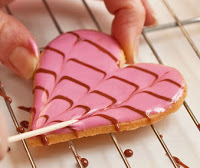
Some brands of liquid botanical colors have a slightly thicker consistency than comparable synthetic dyes, partly because of the natural color pigments themselves and partly because the au naturel brands often incorporate plant glycerin instead of the more fluid but risky propylene glycol found in “regular” food dyes. Propylene glycol is the main ingredient in some kinds of antifreeze!
By the way, I made the cookies using the Good and Easy Sugar Cookies recipe in Simply Sensational Cookies, but for another a rolled sugar cookie recipe that works well, go here.
different colors–bright pink, light pink, chocolate and white. For the
intense pink shown, mix the ingredients with all cranberry juice
concentrate. For a light or medium pink, use about half cranberry juice
concentrate and half water. For the rich, reddish chocolate color
shown, use mostly cranberry juice concentrate instead of water when you
mix up the icing. By the way, the berry juice adds a very pleasant
fruitiness and tang to the icings. (Of course, for a plain white icing, you simply use all water and omit the juice.)
All
together these batches of icing will yield enough to generously
decorate 40 to 60 cookies, depending on their size. I often decorate a
number of cookies using the medium and bright pink colors, then stir in
some white to tone them down for cookies in additional complementary
slightly softer shades. Both the chocolate and the white contrast the
bright pink nicely. Yield: 1 batch of icing will generously decorate 30 to 40 2 1/2- to 3-inch cookies.

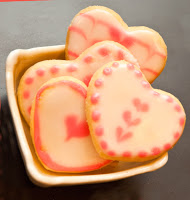
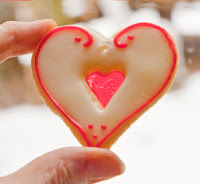
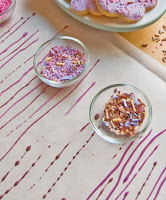

looks neat–goning to try it